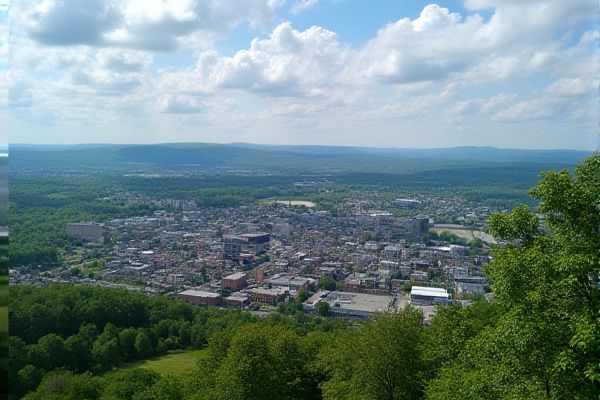
Transportation and commuting in Vermont: Minimal public transportation options available. Extensive network of scenic highways and byways. Carpooling encouraged to reduce environmental impact. Limited rail services between major towns. Bicycle-friendly routes in urban areas. Winter driving requires special precautions. Reliable vehicle needed for rural travel. Burlington has bus and bike-sharing systems. Parking in cities can be challenging. Snow removal may affect road accessibility.
Minimal public transportation options available.
Vermont's public transportation system is characterized by limited and fragmented services, with significant gaps in coverage, particularly in areas of low population density, and a lack of cohesion among the 26 different transportation systems operating in the state. To gain a deeper understanding of these challenges, you can visit the public transportation Vermont report that provides comprehensive insights into the state's transportation dynamics.
Extensive network of scenic highways and byways.
Vermont boasts an extensive network of scenic highways and byways, including ten federally designated scenic byways that range from 14 to 400 miles, connecting historic towns, farms, and natural attractions such as trailheads, waterfalls, and museums, and offering stunning views and recreational opportunities. These byways, like the Green Mountain Byway and the Lake Champlain Byway, are part of the National Scenic Byways Program, promoting tourism and preserving scenic, historic, and cultural significance.
Carpooling encouraged to reduce environmental impact.
Carpooling is encouraged in Vermont as a sustainable commuting option to reduce environmental impact, save money, and minimize traffic congestion. Programs like CarShare Vermont and CATMA (Chittenden Area Transportation Management Association) provide matching services and incentives for green commuting. For more details on the available [commuting options](https://www.burlingtonvt.gov/245/Commuting-Options), you can explore various services that support eco-friendly travel.
Limited rail services between major towns.
Vermont has limited rail services, with Amtrak operating two main lines: the Vermonter and the Ethan Allen Express, which connect major towns in Vermont to each other and to neighboring states. However, there is no commuter rail service within the state. For detailed information on these services, you can visit the Connecting Commuters website.
Bicycle-friendly routes in urban areas.
The VTrans On-Road Bicycle Plan aims to improve the condition of state roads to enhance safety and accommodate bicyclists, categorizing roads into high-, moderate-, and low-use/priority corridors based on current and potential bicycle use, with a focus on high-use priority bicycle corridors in urban areas like Burlington, Colchester, and St. Albans City.
Winter driving requires special precautions.
Winter driving in Vermont requires special precautions, including slowing down, increasing following distance, watching for ice on bridges and overpasses, using properly maintained winter tires, and keeping an emergency kit in the vehicle. It is also important to minimize distractions, avoid cruise control, and be cautious near snowplows. For more detailed guidance on traffic safety during the winter months, the Vermont State Police website provides valuable resources to ensure safer travel on icy roads.
Reliable vehicle needed for rural travel.
In rural Vermont, reliable vehicle access is crucial due to limited public transit options, prompting initiatives like Capstone's Community Rides Vermont, which uses a fleet of electric vehicles with paid drivers to provide subsidized and market-rate rides, especially for those without consistent vehicle access.
Burlington has bus and bike-sharing systems.
Burlington, Vermont, has a comprehensive transportation system including Green Mountain Transit (GMT), which offers bus services with 16 routes and a fleet of 143 buses, serving Chittenden County and surrounding areas. Additionally, the city features a bike-sharing system through Bird, providing electric assist bikes as an environmentally friendly and convenient commuting option, available 24/7 with various pricing and discount programs.
Parking in cities can be challenging.
The Burlington City Council has made a significant change by eliminating minimum parking requirements, opting instead for maximum parking limits. This strategic shift aims to tackle the city's housing crisis, reduce carbon emissions, and promote alternative transportation methods. The council recognizes that mandatory parking minimums often act as barriers to housing development and incentivize single-occupancy vehicle use. This move reflects a broader initiative to create a more sustainable urban environment. For more detailed information, you can visit the official website of the Burlington City Council.
Snow removal may affect road accessibility.
In Vermont, snow removal adheres to a "Safe-Roads-at-Safe-Speeds" policy, ensuring that roads are plowed, salted, and sanded with priority given to interstates and major corridors over rural highways. According to the guidelines on the Vermont Agency of Transportation website, town roads may be cleared more quickly if they utilize more salt, although the decision to plow is contingent upon the road's classification and local policies. It's important to note that roads may not be bare until well after a storm has passed, reflecting a commitment to balanced snow removal operations.
